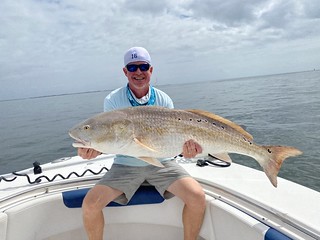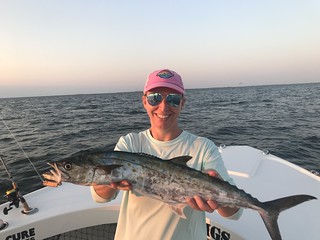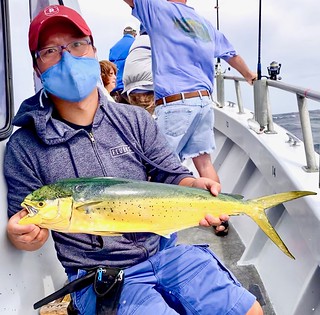Maryland Fishing Report – September 16
CLICK HERE FOR THE SEPT. 23 MARYLAND FISHING REPORT
September always holds promise for the outdoor enthusiast, as the cooler nights and days are like a sweet whisper in the ear about wonderful things to come. Recreational crabbing is at the season’s peak as blue crabs are plentiful, large, and heavy. Do not miss venturing out to enjoy the bounty of the Chesapeake.
The upcoming week will bring cooler days, moderate winds and chance of rain on Friday, continuing to cool Chesapeake Bay waters. Surface water temperatures have cooled to the mid 70s. Recent Department of Natural Resources water monitoring is now showing uniform temperatures from the surface down to the Don’t Fish Below this Depth line in most Maryland bay waters. The only exception is from the Bay Bridge down to the mouth of the Choptank River, where deeper waters are cooler than surface waters. This will result in cool-water preferring fish being able to move more vertically to find suitable oxygen and temperature conditions. This should help improve first light shallow-water fishing conditions when surface water temperatures can be several degrees cooler. For information on Maryland’s bay oxygen conditions, see our latest hypoxia report online.
As a result of below normal flows from the Susquehanna River, upper bay salinities are slightly higher than normal. As always, best fishing areas could be further refined by intersecting these cool, oxygenated areas with underwater points, hard bottom, drop-offs, and large schools of baitfish.
Expect average flows for most Maryland rivers and streams. There will be higher than normal but dropping flows on some of the lower Potomac River and upper Eastern Shore creeks. There will be above average tidal currents all week as a result of the upcoming new moon on Sept. 17. Expect average clarity for Maryland portions of the Bay. To see the latest water clarity conditions, check Eyes on the Bay Satellite Maps.
For more detailed and up-to-date fishing conditions in your area of the bay, be sure to check out Click Before You Cast. Get regular updates on Maryland’s waters sent to your inbox with our Eyes on the Bay newsletter. Sign up online
Anglers fishing at the very top of the bay are finding action with sub-legal striped bass in the early morning and evening hours around the edges of the Susquehanna Flats and the Conowingo Dam pool. Most are casting topwater lures and are finding legal-size striped bass now and then.
The water releases from the Conowingo Dam have been below the seasonal average causing the Susquehanna River water levels to be very low. Fishing for flathead catfish in the dam pool has been good along with a mix of flathead, blue, and channel catfish in the lower river. Fishing for blue and channel catfish has also been good in the lower Elk River. Clam snouts, fresh cut bait, and nightcrawlers have been good baits to use.
Striped bass are being found at a variety of locations in the upper bay this week. The mouth of the Patapsco River and the Key Bridge area has been a productive place to troll jig and there has been some topwater action in the morning and evening hours. Swan Point, the 7-foot knoll, Tea Kettle Shoals, and Love Point are also good places to check this week. Live-lining small white perch and spot continues to be a productive way to fish but trolling and jigging are becoming more popular. Water temperatures are falling and conditions are becoming more comfortable for striped bass so they will be on the move and feeding on schools of small menhaden and bay anchovies along the channel edges where schools of bait are being swept along by currents.
The Bay Bridge piers are a good place to look for striped bass holding to structure. Live lining, drifting peeler crab and cut baits near the bases of the bridge piers. Jigging up close and tight to the bridge piers is also a productive way to fish. Skirted jigs are a real asset and if you’re not chipping paint off your jig heads you are not casting close enough to the bridge piers.
White perch are still holding in the tidal creeks and rivers but recent reports have told of lackluster catches, which may be due to cooler water temperatures. Hopefully this is just a blip on the screen and good fishing will return. Casting beetle spins in the shallower areas near structure has been the most popular way to fish. Out in the bay bottom rigs baited with pieces of bloodworm is the traditional way to fish. In these times of high bloodworm prices, mixing pieces of nightcrawler in with the bloodworm juice on the cutting board can work well and be a little kinder to your pocketbook. The shallower end of the west side of the Bay Bridge, the front of Sandy Point, and the knolls and shoals of the upper bay are traditional places to find white perch.
Fishing for a mix of striped bass, Spanish mackerel and bluefish continues to be good this week but with water temperatures dropping into the mid-70 degree mark, it is possible the Spanish mackerel will not stick around for long. The trio tend to be chasing schools of bay anchovies along the steeper channel edges of the shipping channel. Trolling small Drone or Clark spoons behind planers and inline weights at a good clip is a popular way to catch the Spanish mackerel. Trolling red hoses, spoons, and bucktails at slower speeds is a good way to target bluefish and striped bass along the shipping channel edges.
Breaking fish are being encountered in the middle bay and it is usually a mix of 2-year old striped bass that measure under the 19-inch minimum, along with bluefish and Spanish mackerel. Casting metal jigs and allowing them to sink a bit before speed reeling is a great way to catch the Spanish mackerel. Slower retrieves will attract the small striped bass and the bluefish. Allowing fair-sized jigs to sink below the surface action to the bottom can entice larger striped bass.
Shallow-water fishing for striped bass and speckled trout is good as cooler water temperatures have made life more comfortable for them. Casting topwater lures in the early morning and late evening hours is a fun way to fish. Casting white paddle tails and similar soft plastic jigs with lightweight jig heads works especially well for the speckled trout.
Casting spinners and beetle spins in the shallower areas of the tidal rivers and bay shores is a fun way to fish for white perch, and small puppy drum are also being caught. As water temperatures in the tidal rivers begin to drop in the next week or so, white perch will be heading for deeper waters over oyster reefs. Fishing with dropper rigs or bottom rigs baited with pieces of bloodworms will be the best way to catch them.
Anglers in the lower bay are targeting a wide variety of species — striped bass, Spanish mackerel, cobia, red drum, bluefish, and speckled trout, as well as bottom fishing for flounder, spot, and white perch.

Bob Bruns cradles a large red drum that he caught while jigging for a quick picture before sliding it back into the bay. Photo courtesy of Bob Bruns
Striped bass are being caught in the lower Potomac River by those trolling spoons, bucktails, and diving crankbaits. They are also being caught by live-lining spot along the channel edge between St. Georges Island and Piney Point. Many are of good size at 5 pounds or better. Smaller striped bass are in the mix with bluefish and Spanish mackerel chasing bay anchovies. If one jigs under the surface action close to the bottom, larger striped bass can often be caught. One may also get hooked up to a large red drum, which has the habit of lurking underneath breaking fish.
Trolling gold Drone and Clark spoons has been a very popular way to catch Spanish mackerel this week, both are being pulled at a fast clip behind #1 and #2 planers or heavy inline weights. The eastern side of the shipping channel, the mouth of the Patuxent and off Point Lookout have been three of the best places to troll for them.
There has been a flurry of cobia activity near the Target Ship for the past week and they are mostly being caught by sight fishing and casting live eels or large soft plastic jigs. This fishery will not last long so if a cobia is on your list, don’t miss out on the action right now.
The shallow-water fishery for speckled trout continues to be a real treat for light-tackle anglers who enjoy fishing the shallower areas along marsh edges, prominent points and grass beds. Most are casting white or pink paddletails with light jig heads. At times, striped bass and puppy drum can be part of the mix. Drifting peeler crab or soft crab baits on a good ebbing tide in the creeks and guts that drain from the marshes of the Eastern Shore is a productive way to fish for speckled trout with the bonus of a slot size red drum now and then.
Fishing for a mix of spot and white perch with a few speckled trout mixed in has been extremely good, particularly at the mouth of the Patuxent, the Point Lookout area, Tangier Sound, and the mouth of the Honga River. Many of the spot are now sized to offer fun fishing and great table fare. Pieces of bloodworm on a bottom rig are the most popular bait but peeler crab can work well. Fishing for flounder in the Tangier and Pocomoke sounds has been good for those who target them along hard bottom shoal areas next to channels.
September often is what one might call the zenith of the recreational crabbing season, and this week is just that. Crabs are filling out from last week’s big shed and are at their seasonal peak size and abundance. Reports from all regions of the bay speak of bountiful catches of heavy crabs. Many of the best catches tend to be coming from shallower waters, and razor clams continue to be the most favored bait.
The fall stocking of trout is coming up in October and now is a good time to prepare tackle for yourself and any young anglers. The trout hatchery program reports the fish are in great shape due to good water flows at the hatcheries and our crews are eager to stock them. Due to COVID-19 restrictions on field operations, the stocking crews will not be able to use the volunteers that are usually employed to spread trout out along streams and rivers by float and bucket stocking. The stocking crews will do their best to spread the trout out whenever possible.
A few things on everyone’s checklist would be monofilament line, hooks, something to put your trout in, and that jar of Powerbait that you most likely have not looked at since last spring. Make sure your fishing license and trout stamp is current and you know where it is. Keep an eye out for updates on the trout stocking website and other communications.
Cooler air temperatures quickly have an effect on trout streams and rivers. Although flows are scant in many waters in the western and central regions, fly fishermen are enjoying wonderful catch-and-release fishing. It takes a careful approach when waters are skinny but trout are very active and will take a variety of nymphs, terrestrials, and streamers.
Fishing for smallmouth bass in the upper Potomac River has been slow. Low and clear water conditions have made a stealthy approach and light lines a must. Casting to submerged ledges with tubes in crayfish colors and light ⅛-ounce jig heads tends to be the best tactic.
Many freshwater species of fish will start to feel the cooling water temperatures and the fact we lose about 15 minutes a week in daylight. Grass will begin to diminish and this will cause baitfish and food items such as crayfish to look for alternative cover. Right now the grass beds are a great place to fish in the morning and evening hours with topwater lures and soft plastics. Largemouth bass will begin to feed heavily as they find cooler water temperatures more comfortable and feel the urge to fatten up for the winter.
Transition areas between the shallow grass beds and deeper waters are a great place to fish with spinnerbaits, crankbaits, and jerkbaits. Drop-offs and submerged structure are good places to work crankbaits that resemble crayfish, grubs and tubes are also a good choice. In tidal waters, main river points and feeder creeks are good places to target. On a falling tide the outside edges of grass beds and spatterdock fields are good places to cast spinnerbaits and jerk baits.
Northern snakeheads will still be found holding near grass but will be more common on the outside edges and submerged wood such as fallen brush or tree branches. White paddle tails rigged weedless is a proven bait. Large live minnows under a bobber or lip hooked and worked near shoreline structure will also work well.
Crappie are schooling up in deeper waters near bridge piers, marina docks or sunken brush or treetops. A slip bobber rigged with small minnows or a marabou jig work well near these structures.
Fishing for blue catfish and other species of catfish is about as good as it gets this month. Slightly cooler water temperatures have spurred catfish into increased feeding activity. The larger blue catfish will be found in the deeper channel areas but small blue catfish will be found along channel edges. Channel catfish will be found along the deeper areas of the tidal rivers and a few impoundments such as Piney Run Reservoir. Flathead catfish can be found in the upper Potomac, the Conowingo Dam Pool, and the lower Susquehanna River. Fresh cut bait will work well for all species and clam snouts are a durable bait; nightcrawlers and chicken liver work well for channel catfish.
Fishing for a mix of kingfish and spot in the surf areas continues to be good. Surfcasters are also catching bluefish on finger mullet or cut mullet rigs. Flounder can be caught on squid.
At the inlet, bluefish are being caught by those casting bucktails and metal lures, or drifting cut bait or live spot and mullet. Striped bass are also being caught with most shy of the 28-inch minimum. Flounder fishing is good for those walking their baits in the sweeping current. Sheepshead are being caught near the bases of the jetties on pieces of green crab and to a lesser extent on sand fleas.
Flounder fishing is very good in the channels leading to the inlet. Boat traffic is down making for more comfortable fishing; the bay waters are clear and the flounder bite is on. Gulp baits in white or pink are catching the largest flounder, but drifting live spot or finger mullet will entice the largest flounder to strike. Traditional baits of squid and minnows always work well but increase the number of small flounder being caught.
The boats heading out to the wreck and reef sites are catching sea bass, but catches of small dolphin tend to be taking center stage for anglers on the party boats. Recent rough conditions have made offshore trips a bit difficult but the boats that do venture to the canyons are catching yellowfin tuna, dolphin, and white marlin.
Based on the best available landings information, NOAA Fisheries has determined that the Atlantic blue marlin, white marlin, and roundscale spearfish 250-landings limit has been met and exceeded for 2020. Under applicable regulations, only catch-and-release fishing is permitted for these species through Dec. 31 in all areas of the Atlantic Ocean. Anglers are reminded that Atlantic billfish that are released must be handled in a manner that will maximize survival, and without removing the fish from the water. For additional information on safe handling, see NOAA’s Careful Catch-and-Release brochure.
“Fishing is discipline in the quality of man — for all men are equal before fish.” — President Herbert Hoover
Maryland Fishing Report is written and compiled by Keith Lockwood, Maryland Department of Natural Resources fisheries biologist.
Click Before You Cast is written by Tidewater Ecosystem Assessment Director Tom Parham.
This report is now available on your Amazon Echo device — just ask Alexa to “open Maryland Fishing Report.”






 1-888-373-7888
1-888-373-7888 233733
233733